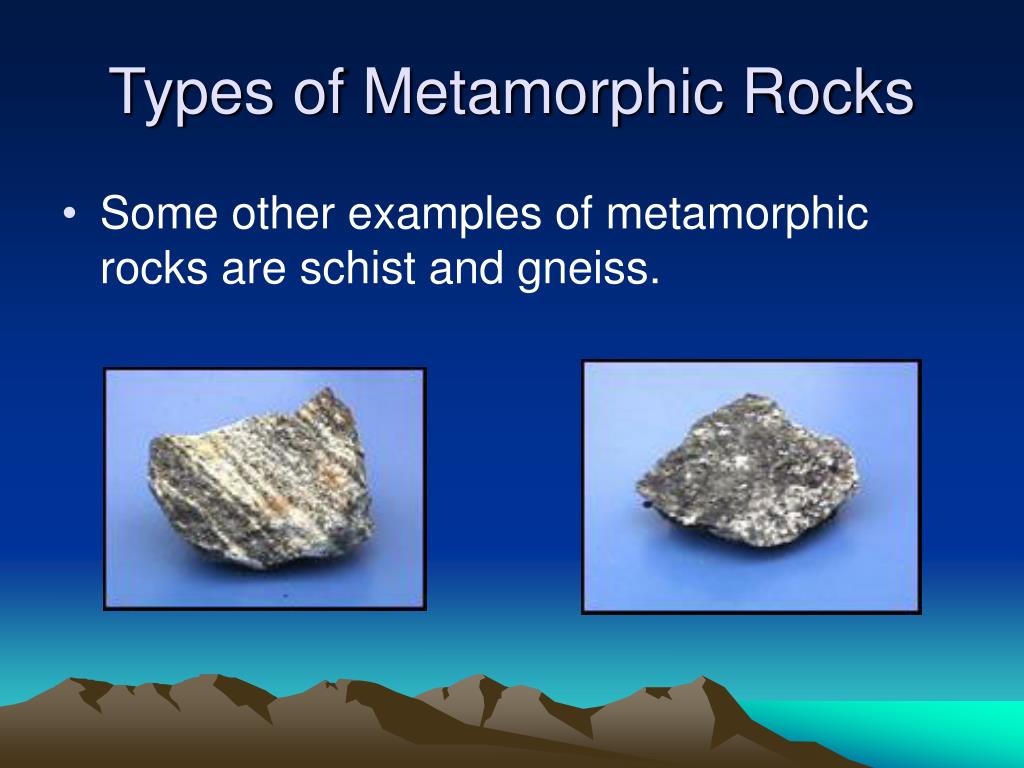
10 Types Of Metamorphic Rocks
1. What are Metamorphic Rocks? Metamorphic rocks are a type of rock that forms from the transformation of pre-existing rocks due to intense heat, pressure, and chemical reactions. These rocks undergo a process called metamorphism, which changes their mineral composition and physical properties. Metamorphic Rocks Definition

Metamorphic Rock Facts for Kids Information & Examples
A metamorphic rock is a type of rock which has been changed by extreme heat and pressure. Its name is from 'morph' (meaning form), and 'meta' (meaning change). The original rock gets heated (temperatures greater than 150 to 200 °C) and pressured (1500 bars ). This causes profound physical and/or chemical change.

Metamorphic Rock...grade 5 rock cycle 5th Grade Science, Science Fun, Science Ideas, Science For
Metamorphic rocks are classified into two different types based on their texture, how minerals align in the newly formed rock. 1. Foliated Sedimentary Rocks. Foliated rocks are rocks that possess a layered appearance. They are formed through extreme pressure in conjugation with heat, which helps elongated minerals attain a foliated pattern.

American Educational Identifying Metamorphic Rock Chart Industrial & Scientific
Metamorphic rocks make up a large part of the Earth's crust and form 12% of the Earth's land surface. [2] They are classified by their protolith, their chemical and mineral makeup, and their texture.

Interesting Metamorphic Rocks Facts YouTube
Article Vocabulary The term "metamorphosis" is most often used in reference to the process of a caterpillar changing into a butterfly. However, the word "metamorphosis" is a broad term that indicates a change from one thing to another. Even rocks, a seemingly constant substance, can change into a new type of rock.

PPT Haiku Poetry about Rocks PowerPoint Presentation, free download ID290788
A metamorphic rock used to be some other type of rock, but it was changed inside the Earth to become a new type of rock. The word metamorphism comes from ancient Greek words for "change" (meta) and "form" (morph). The type of rock that a metamorphic rock used to be, prior to metamorphism, is called the protolith.
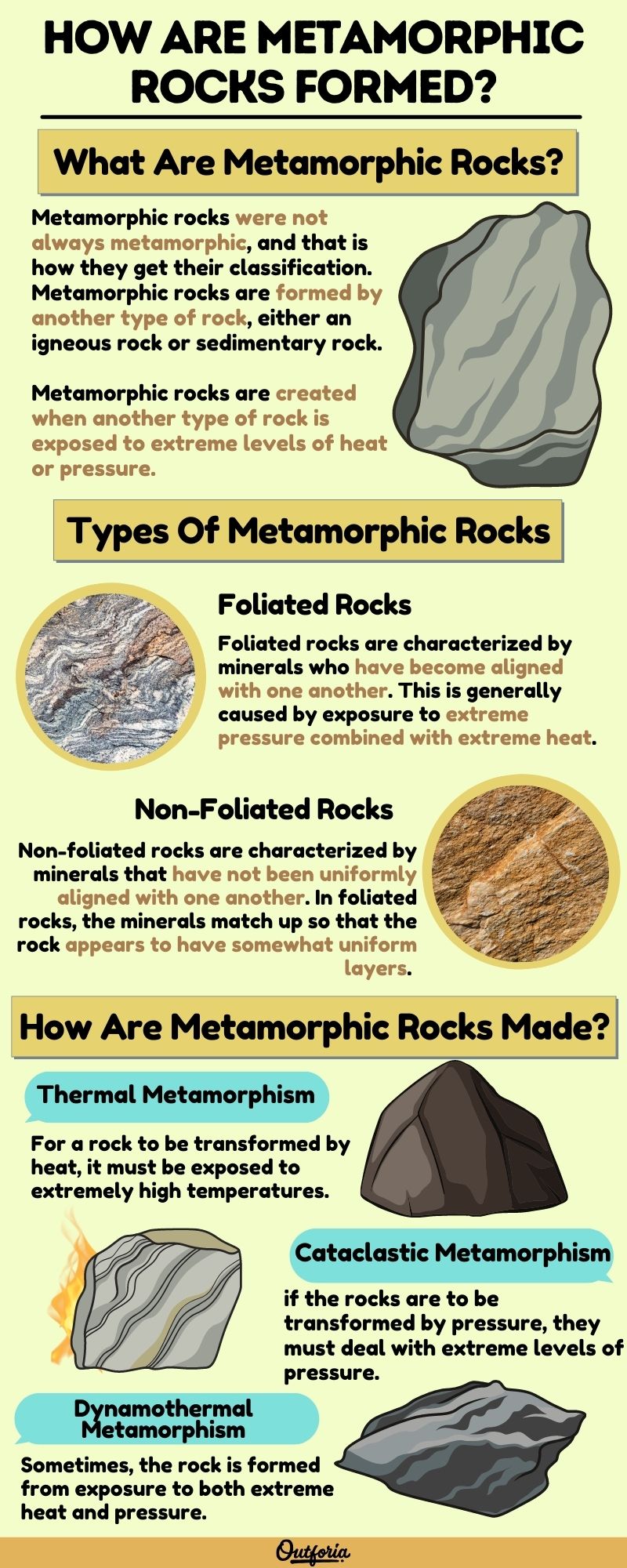
How Are Metamorphic Rocks Formed? (Full Explanation) Outforia (2022)
Slate, a metamorphic rock, can form from either clay, shale, or mudstone. Quartzite is a metamorphic sandstone. Marble is a metamorphic rock formed from the sedimentary rock of limestone. Granulite is a metamorphic rock formed from the igneous rock of basalt. Anthracite is a type of coal, and although coal is a sedimentary rock, anthracite is a.
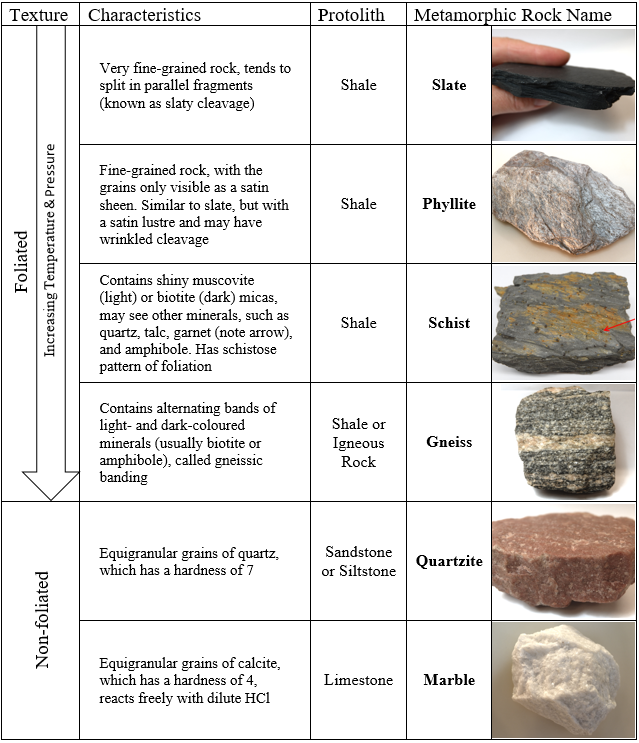
Igneous Metamorphic And Sedimentary Rocks Chart
1. Exhibit Interesting Foliation Features The foliation feature is one of the fascinating things about metamorphic rocks. This property refers to the alignment of the structural features or mineral grains within metamorphic rocks. As metamorphic rocks go under extreme pressure and heat, they develop foliation.
brhectorsgeoworld 9A6ROCKS
Uplift and erosion help bring metamorphic rock to the Earth's surface. Examples of metamorphic rocks include anthracite, quartzite, marble, slate, granulite, gneiss and schist. Anthracite is a type of coal with a high carbon count, few impurities and with a high luster (meaning it looks shiny). Marble is a metamorphic rock that is formed from.

Metamorphic Rocks Rock Cycle Project
1. Metamorphic rocks are composed of layers Metamorphic rocks are formed by intense heat and pressure applied to existing rocks over time. This heat and pressure cause the rock to recrystallize and form different layers. This stratification of rocks is caused by the pressure exerted on the rocks and the arrangement of minerals they contain.
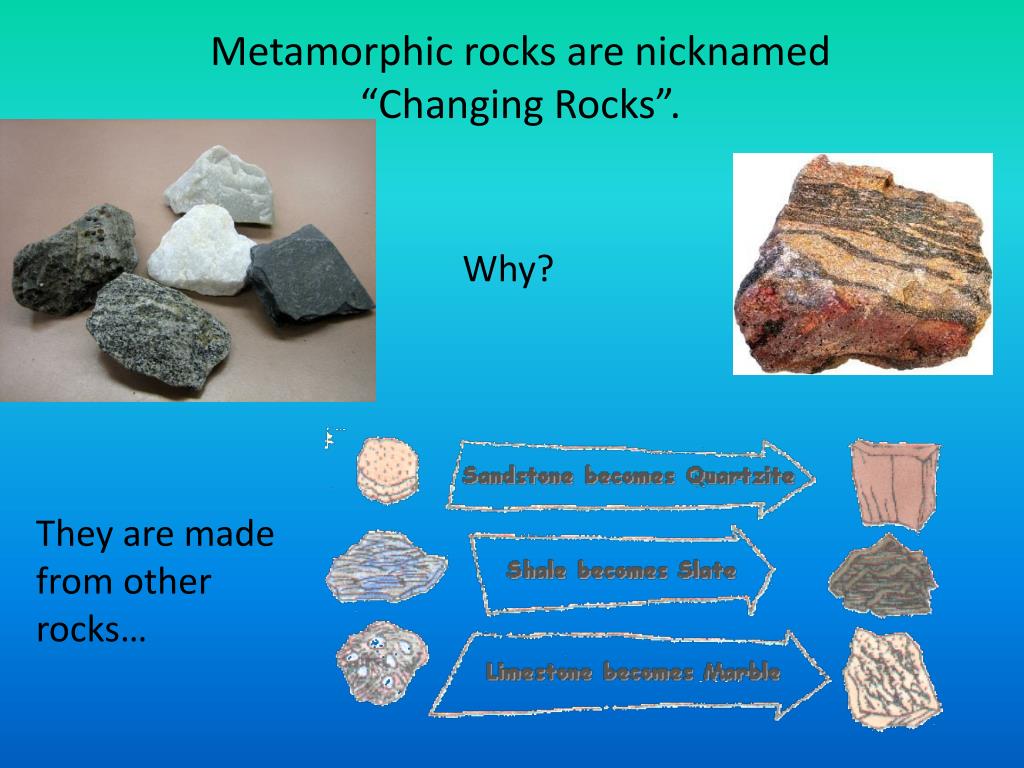
PPT Metamorphic Rocks PowerPoint Presentation, free download ID2924874
Andrew Alden Updated on September 18, 2019 Metamorphic rocks are the third great class of rocks. They occur when sedimentary and igneous rocks become changed, or metamorphosed, by conditions underground. The four main agents that metamorphose rocks are heat, pressure, fluids, and strain.
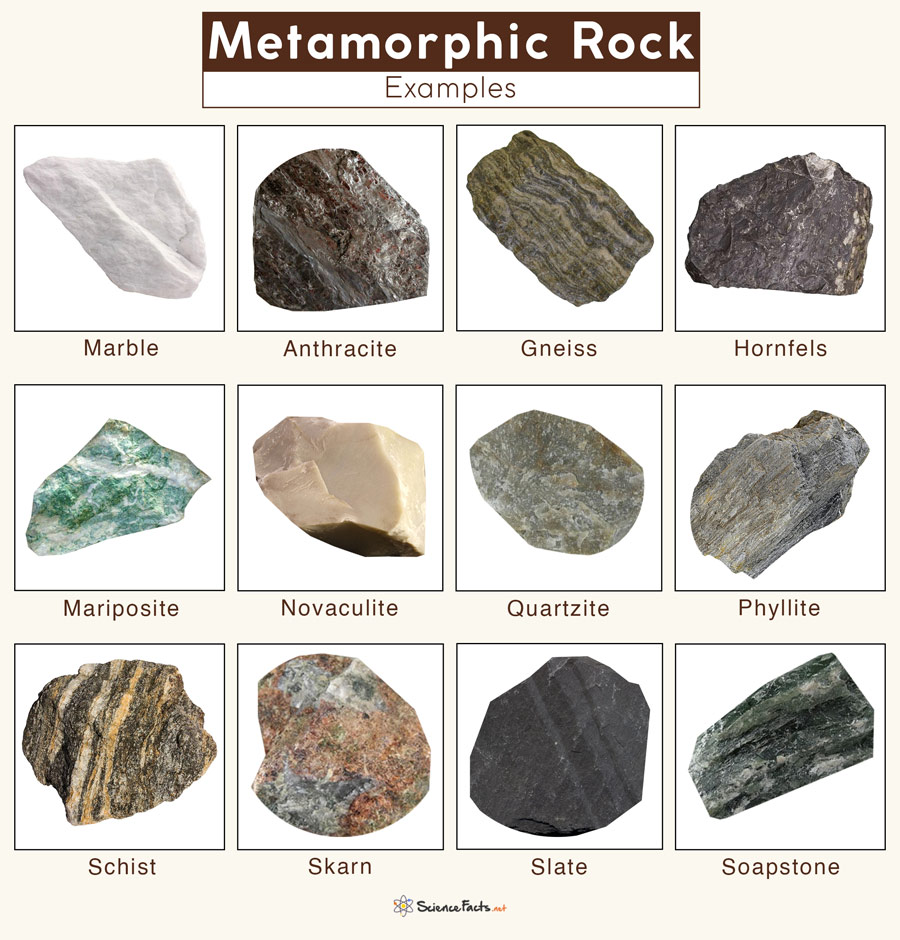
Metamorphic Rocks Definition, Formation, Types, & Examples
Metamorphism occurs when existing rock is subjected to high temperature and pressure, causing it to undergo physical and chemical changes. Metamorphic rock can be derived from any type of pre-existing rock. Whether it's sedimentary, igneous, or even another metamorphic rock, any rock can undergo metamorphism and transform into a new type of rock.
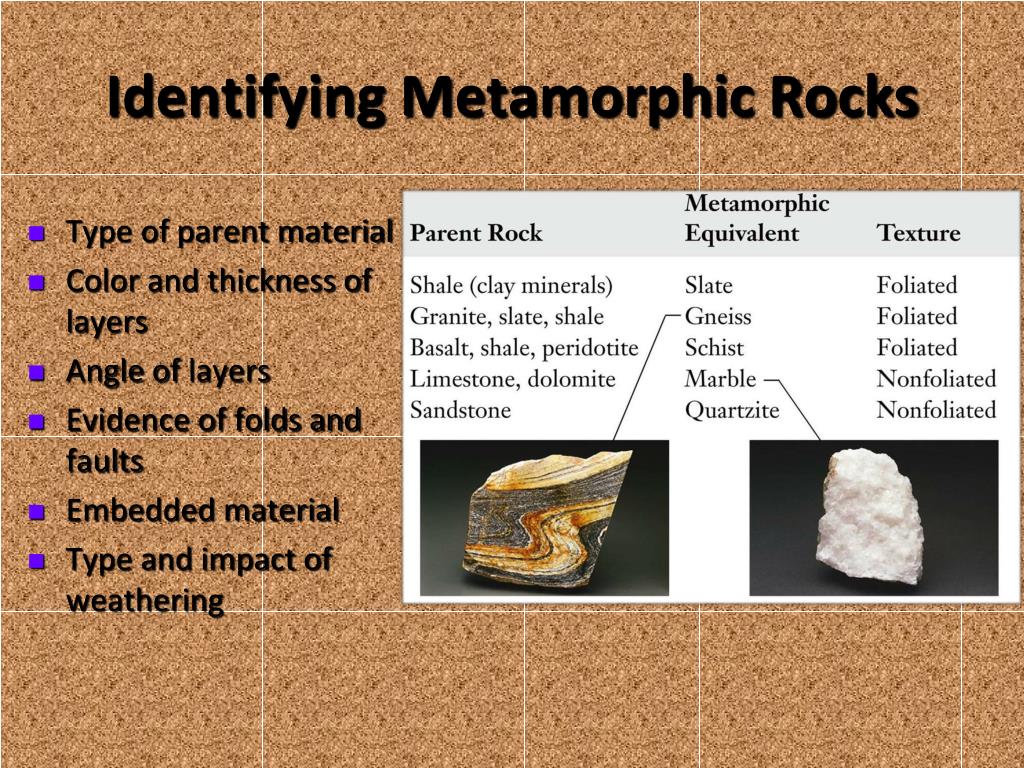
PPT Geology PowerPoint Presentation, free download ID3073696
Earth & Soil Metamorphic Rock Fun Facts for Kids All About Metamorphic Rock - Image of Metamorphic Rocks The Seasons Metamorphic rocks are formed through the process of metamorphism, which involves the transformation of existing rocks due to high pressure, temperature, or chemical changes.

Fun facts about igneous sedimentary and metamorphic rocks 7volts
6.1: Prelude to Metamorphic Rocks. Metamorphic rocks is one of the three rock categories in the rock cycle. Metamorphic rock material has been changed by temperature, pressure, and/or fluids. The rock cycle shows that both igneous and sedimentary rocks can become metamorphic rocks. And metamorphic rocks themselves can be re-metamorphosed.

6 Metamorphic Rocks Rock (Geology) Structure Of The Earth
Marble is a metamorphic rock that formed from limestone. Schist is a metamorphic rock that can form from slate, another type of metamorphic rock. Metamorphic literally means "changed form.". Slate is a metamorphic rock formed by shale, clay, or mudstone. The Taj Mahal in India is entirely made of various types of marble, a metamorphic rock.

Overview of Metamorphic Rocks Laboratory Manual for Earth Science
Updated on May 10, 2019 Metamorphic rocks are an important topic in geology. These are the rocks that form by the effects of heat, pressure, and shear upon igneous and sedimentary rocks.